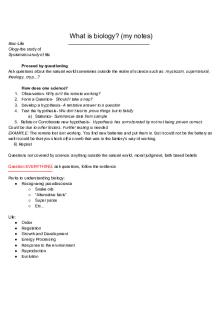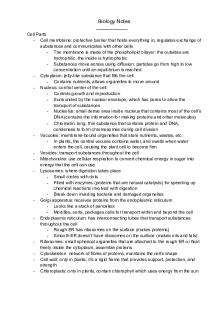Photosynthesis - A-Level Biology notes PDF

| Title | Photosynthesis - A-Level Biology notes |
|---|---|
| Course | Biology - A2 |
| Institution | Sixth Form (UK) |
| Pages | 3 |
| File Size | 208.7 KB |
| File Type | |
| Total Downloads | 99 |
| Total Views | 151 |
Summary
A-Level Biology notes...
Description
Chapter 11: Photosynthesis 11.1 Overview of photosynthesis - The leaf is the main photosynthetic structure in eukaryotic plants - Chloroplasts are the cellular organelles in the leaf where photosynthesis occurs Adaptation of the leaf: - Large surface area for maximum absorption of light - And arrangement of leaves that minimises overlapping - Thin for a short diffusion path - Transparent cuticle allowing epidermis to let light through to mesophyll cells - Long and narrow upper mesophyll cells are packed with chloroplasts - Numerous stomata for gas exchange - Stomata open and closes which helps control water loss - Many airspaces in the lower mesophyll to allow rapid diffusion of CO2 and O2 - A network of xylem and phloem Main stages of photosynthesis: 1. Capturing of light energy 2. Light dependent reaction 3. Light independent reaction Structure and role of chloroplasts in photosynthesis: - Disk shaped, 2-10 um, long and 1um wide. - Double membrane - Grana are stocks of up to 100 thylakoids where the light dependent reaction occurs - Some thylakoids have tubular extensions that join up with thylakoids in adjacent grana - Stroma is a fluid filled matrix where the light independent reaction occurs. Within this stroma there are a number of other structures like starch grains 11.2 The light dependent reaction Light energy is used to: - Add inorganic phosphate to ADP to make ATP - Split water to H and OH by photolysis
Oxidation: when a substance loses electrons and energy is given out Reduction: when a substance gains electrons and energy is taken in
Making of ATP: 1. A chlorophyll molecule absorbs light energy and excites a pair of electrons within the molecule 2. The pair of electrons reach a high energy level and leave the molecule 3. The chlorophyll molecule becomes ionised by photoionization 4. The pair of electrons that left, are picked up by an electron carrier 5. Chlorophyll molecule becomes oxidised and the electron carrier is reduced 6. The pair of electrons pass along a number of electron carriers in a series of oxidation-reduction reactions. These electron carriers form a transfer chain located in the thylakoid membrane 7. As the electrons move along they lose energy which is then used to phosphorylate ADP. Chemiosmotic theory: 1. Each thylakoid is an enclosed chamber into what H protons are pumped from this stroma using proton pumps in the membrane 2. Energy for this process comes from photolysis of water 3. Photolysis of water also produces protons which further increase their concentration inside the thylakoid space 4. Overall this creates and maintains a concentration gradient of protons with a high concentration in the thylakoid space and a low concentration in the stroma. 5. Protons can only cross the thylakoids membrane through ATP synthase channel proteins. These channels form small granules on the surface membrane 6. As the protons pass through ATP synthase channels they cause changes to the structure of the enzyme which then catalyses the phosphorylation of ADP.
Chapter 11: Photosynthesis
Photolysis of water: - If the chlorophyll molecule continues to absorb light energy, then the pair of electrons that left need to be replaced. This is done by splitting water molecules using light energy.
-
The protons pass out of the thylakoid space through the ATP synthase channels and are taken up by NADP (an electron carrier) When NADP takes of protons it becomes NADPH (reduced NADP) NADPH is a source of chemical energy to the plant which is passed on to the light independent reaction Oxygen is a by-product of photolysis and is either used in respiration or it diffuses out of the leaf as waste
The light dependent reaction occurs in the thylakoids of chloroplasts. Chloroplasts adaptation for the process: - Large surface area - A network of proteins in the grana hold the chlorophyll in a precise manner to maximise absorption of light - Granal membranes have ATP synthase channels which make ATP and are selectively permeable which allows establishment of a proton gradient - Chloroplasts have both DNA and ribosomes so they can easily and quickly manufacture proteins
Chapter 11: Photosynthesis 11.3 the light independent reaction - Occurs in the stroma - Worked out by Melvin Calvin 1. CO2 from the atmosphere diffuses into the leaf through the stomata and dissolves in water around the walls of mesophyll cells 2. CO2 reacts with a 5 carbon compound ribulose bisphosphate (RUBP) which is catalysed by Rubisco enzyme 3. This reaction results in 2 molecules of 3 carbon glycerate 3 phosphate (G3P) 4. NADPH is used to reduce G3P to triose phosphate (TP) using ATP 5. N ADP is reformed and returns to the light dependent reaction 6. Some TP molecules are converted to organic substances that are needed for the plant 7. Most TP molecules are used to regenerate RUBP using ATP from the light dependent reaction Adaptations of chloroplasts for this reaction: - Fluid of the stroma contains all the enzymes needed to carry out the light independent reaction - Stroma fluid surrounds the grana so products of the light dependent reaction can readily diffuse into the stroma - Contains DNA and ribosomes so it can easily manufacture proteins....
Similar Free PDFs

Photosynthesis Notes AP Biology
- 6 Pages

Essay questions Biology Alevel 9700
- 16 Pages

Ch 5- Photosynthesis - biology
- 3 Pages

Photosynthesis Notes
- 4 Pages

Photosynthesis Notes Kahoot
- 1 Pages

Bot 120 Notes Photosynthesis
- 37 Pages

Biology Notes
- 7 Pages

Biology Notes
- 16 Pages

Photosynthesis Lab
- 8 Pages

Photosynthesis PAG
- 2 Pages
Popular Institutions
- Tinajero National High School - Annex
- Politeknik Caltex Riau
- Yokohama City University
- SGT University
- University of Al-Qadisiyah
- Divine Word College of Vigan
- Techniek College Rotterdam
- Universidade de Santiago
- Universiti Teknologi MARA Cawangan Johor Kampus Pasir Gudang
- Poltekkes Kemenkes Yogyakarta
- Baguio City National High School
- Colegio san marcos
- preparatoria uno
- Centro de Bachillerato Tecnológico Industrial y de Servicios No. 107
- Dalian Maritime University
- Quang Trung Secondary School
- Colegio Tecnológico en Informática
- Corporación Regional de Educación Superior
- Grupo CEDVA
- Dar Al Uloom University
- Centro de Estudios Preuniversitarios de la Universidad Nacional de Ingeniería
- 上智大学
- Aakash International School, Nuna Majara
- San Felipe Neri Catholic School
- Kang Chiao International School - New Taipei City
- Misamis Occidental National High School
- Institución Educativa Escuela Normal Juan Ladrilleros
- Kolehiyo ng Pantukan
- Batanes State College
- Instituto Continental
- Sekolah Menengah Kejuruan Kesehatan Kaltara (Tarakan)
- Colegio de La Inmaculada Concepcion - Cebu





